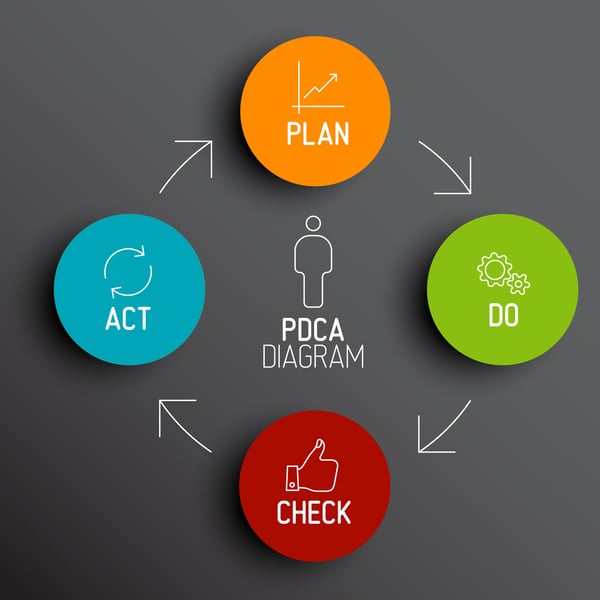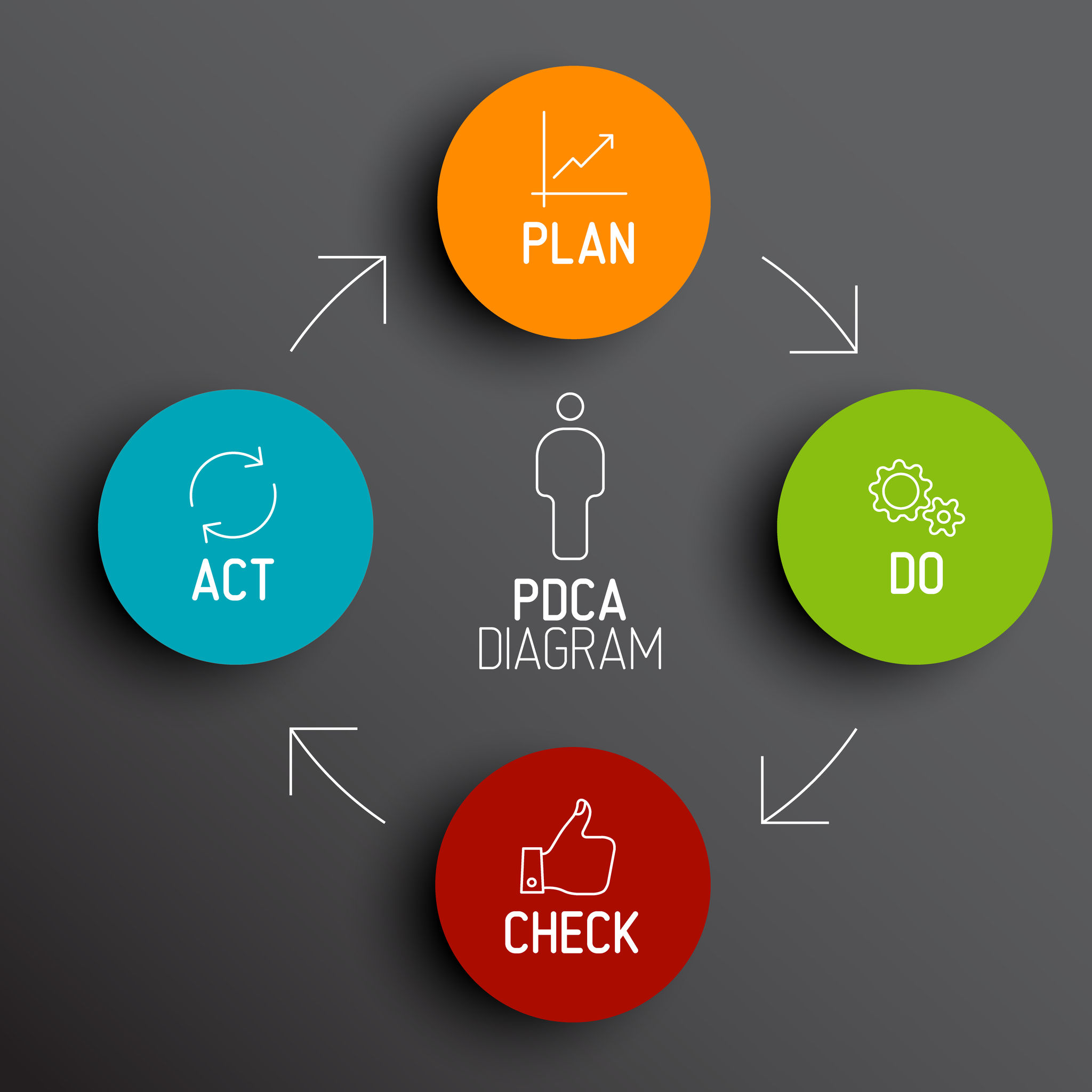The success to any marketing effort begins with a solid measurement plan. If you don't know where you are going, how will you know when you get there?
When it comes to digital marketing for small business, we really like to use the information provided by Google Analytics to develop a measurement plan. If you are not familiar with Google Analytics, you need to know that it is free and easy to install on your website. Don't know know if you have it? Schedule A Time To Talk.
How do you develop a measurement plan? Watch this video from Google.
Once you have decided what to measure, one stumbling block is having a simple and easy-to-use methodology to know if you are on track with your measurement plan. OKRs help make your measurement plan easy to understand by all stakeholders.
What Are OKRs in digital marketing?
John Doer, the author of Measure What Matters, is well known for his implementation of OKRs with companies like Google and Intel.
OKRs = Objectives and Key Results
If you are familiar with PDCA (Plan, Do, Check, Act) from the quality world, OKRs will seem very intuitive. The concept is simple. If you can't measure it, you can't manage it. If you can't manage it, you can't improve it. These basic principles can be traced back to W. Edwards Deming and Walter Shewart for developing and championing this PDCA model.
The PDCA cycle-- Plan, Do, Check, Act-- has no end. It is a continuous improvement cycle you should always be evaluating for effectiveness.
OKRs provide a framework for the PDCA model in alignment with overarching company goals and initiatives. Objectives are what you want to accomplish and Key Results are how you will get them done. This approach allows you to clearly articulate what you are looking to improve and how you will know it has been improved. The Key results should be stretch goals, meaning if you are easily and consistently reaching 100% Key Result success rate, then you are setting the bar too low.
Using Objectives to improve your digital marketing
A common problem that most businesses face are multiple initiatives occurring at the same time and not knowing what to focus on. My first job was at the University of Kentucky and I remember the inter office mail folders arriving on my desk. These folders contained the various initiatives that had been launched. One big problem I had as someone new to such a large organization was trying to figure out what was important and what impact I was supposed to have. I remember being reprimanded by my manager for not accomplishing a specific initiative. I brought a folder that contained all the initiatives with me to the follow-up meeting. I asked what I thought was a fair question: Which one of these is the most important? That did not go over so well- but it was a fair question. If you do not have a clear focus and a defined outcome, how do you know if you are making progress?
Fast forward many years and I read a book called The 4 Disciplines of Execution. One aspect of their approach that resonated with me was the amount of case studies that showed the effectiveness of the PDCA (plan-do-check-act) cycle. While they used the terms, 'WIG' (Wildly Important Goal), 'Lead Measures', 'Scoreboard', and 'Cadence of Accountability', the concept is a refresh of PDCA from Quality 101. You might want to read PDCA: The 4 Steps of Effective Marketing.
Objectives should be so clear the everyone in the organization knows exactly what they are supposed to do.
| Vague | Clear |
| Get more website visitors | Increase monthly website visitors by 10% |
| Improve customer satisfaction | Raise Customer Satisfaction Rate from 6 to 8 |
The data from the research in The 4 Disciplines of Execution shows that the more initiatives you have, the less you will accomplish. Key Results should use the X to Y by When method.
Key Results - if you don't measure it, you won't know if you have improved your marketing
We really like the principles outlined in the 4 Disciplines of Execution.
Simply Put: X to Y by When.
This eliminates any ambiguity and follows the SMART goal methodology. Set wildly important goals (WIGs) to focus your priorities. Limit yourself to 1 or 2 Wildly Important Goals. The more goals you set, the less you will accomplish (The research included in the book clearly shows this to be true). The Pareto principle holds true. 20% of your activity will produce 80% of your results. Understand the difference between a Lead and Lag measure. Lag measures are the results of your goal. Lead measures are the jobs to be done to accomplish your goal.
"A common example of a lag measure is weight loss. Which activities or lead measures will lead to weight loss? Diet and exercise! Proper diet and exercise predict the success of weight-loss and they are activities that we can directly influence. Simple enough, but be careful. Even the smartest people fall into the trap of fixating on a lag measure that they can’t directly influence. This is because lags are easier to measure and they represent the result we ultimately want. Think of a lead measure as a level that moves your wildly important goal."
Source:https://www.franklincovey.com/thcie-4-disciplines/displine-2-act/
Measure What Matters
How do you know what to measure?
There are two contrarian approaches to use when determining what to measure. Amplify success or correct failures. If it ain't broke, you don't need to fix it or If you don't know what is broken, you won't know what to fix.
Sounds simple enough, right? I don't know about you, but it seems many companies get lost in the weeds with data and miss what I strongly believe are the two most important areas of focus.
Does it improve customer satisfaction?
Does it impact revenue/profit?
One small business owner I was working with had set a goal of more social media likes. As is my habit, I asked why?
Crickets. They were not sure, so I asked if they had seen a relationship between social media likes and revenue. They were not sure because this was something they had not measured. As a follow up question, I asked if they had looked at Google Analytics to see the influence social media had on revenue generation and customer retention and was it part of their attribution model? Likes may very well lead to revenue generation, but you need the supporting data to make the business case. No guesses or gut feelings. Start with data.
You need to measure what matters. This takes time, research, thought, and input from stakeholders. As you think about your continuous improvement process, a good place to start is customer complaints. What impact do customer complaints have on retention? Customer Lifetime Value? Focus on revenue generation in the near- and long-term.
Measure what negatively impacts your business.
Measure what positively impacts your business.
Example:
As you evaluate your marketing, you discover that your best customers follow a distinct path. It may be that they download a specific white paper and 3 days later submit an RFQ. As you evaluate Customer Lifetime Value, you determine that visitors to your website from organic content convert at a higher rate. This data is yelling at you. Be quiet and listen. Don't look for what is not there. Instead, pay attention to what is there.
Where to Start with OKRs for Small Business Marketing
Let's start with your website. We strongly recommend you use Google Analytics to set goals for your website. Here is an idea, this could be your first OKR!
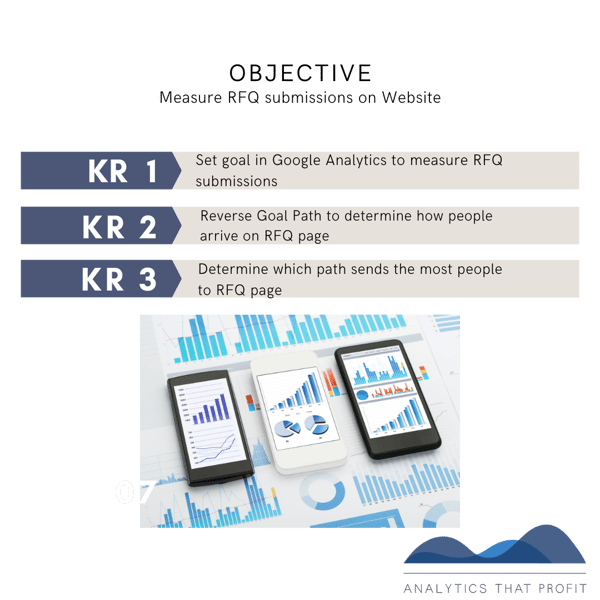
There you have it. Your first use case using OKRs to improve your digital marketing!
Your goal would look something like this in Google Analytics.

You can also have parallel Key Results with a single Objective.
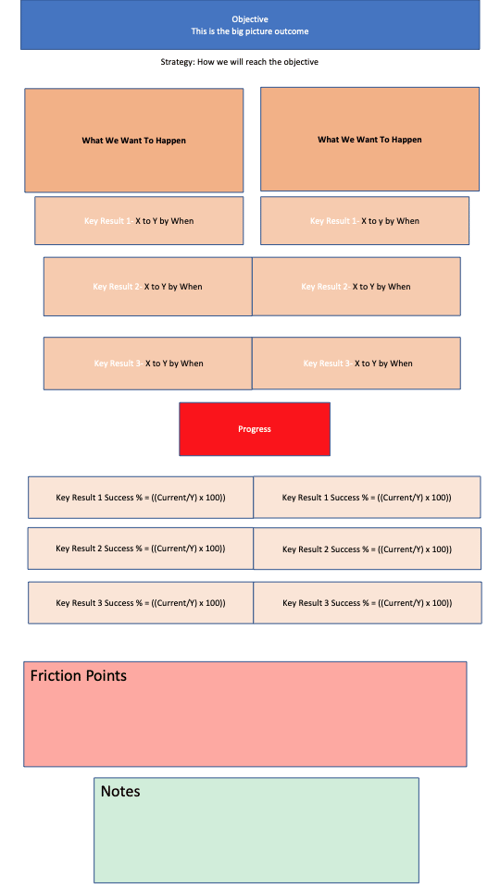
You probably noticed we introduced a Key Result success %. This is an effective method to measure your progress.
If you quickly and easily get 100%, then you need to set your goal higher- a stretch goal.
Now take the same Objective we used above and go into greater detail.
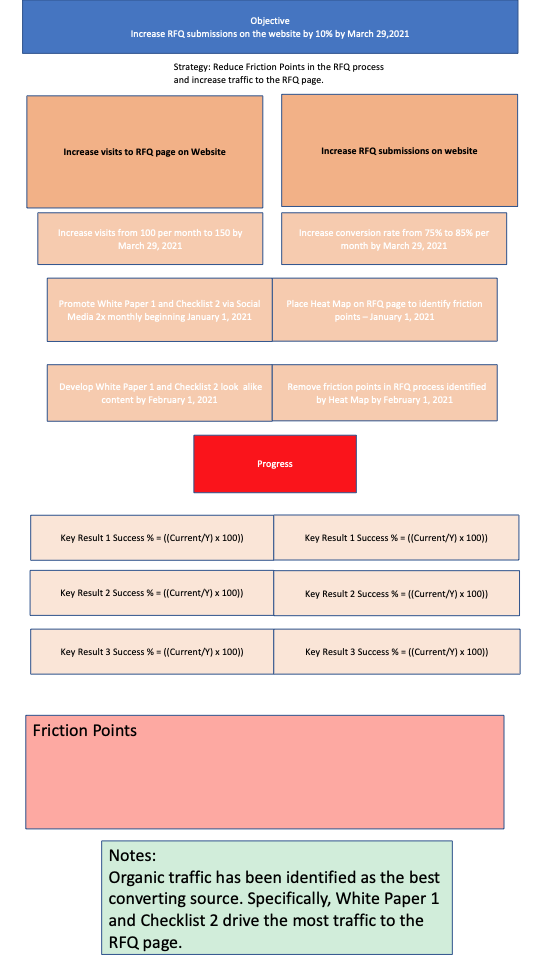
It is common practice to set next year's goals at the end of a current year, but OKRs can and should be used as part of your continuous improvement process. Not sure where to start? We are here to help.
Kick-Start Your Marketing by Creating a Custom Service Audit Package from the Following Offerings:
Website Audit
Technical SEO Audit
Topic Cluster Research
Google Analytics Audit
Competitive Analysis
Keyword Research



